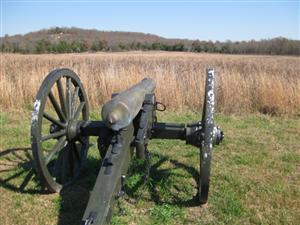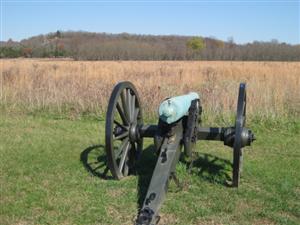Federal Artillery Line
Pea Ridge NMP Tour Stop #10
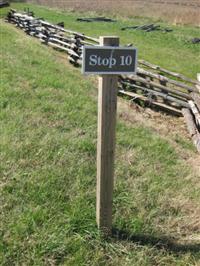
- After reading the interpretive signs, follow the mowed section to the western most gun carriage [ Waypoint = N36 27.070 W94 01.708 ]. It's over 500 yards or about one third of a mile.
- Stop every now and again and look north and northeast towards the Skirt of Timber [ Waypoint = N36 26.967 W94 01.336 ] that marks the Confederate line of battle.
- You can also use the East Overlook Pavilion [Waypoint = N36 27.252 W94 01.375 ] that is readily seen to the north to help locate the site of the Rocky Outcrop Bombardment [ Waypoint = N36 27.270 W94 01.119 ].
- When you reach the gun carriage that marks the location of Welfley’s Independent Battery, Missouri Light Artillery [ Waypoint = N36 27.070 W94 01.708 ], stop and look to the northeast towards th Confederate batteries in front of the Skirt of Timber.
“Dat De Shpot, Sergent!” Interpretive Sign text reads as follows:
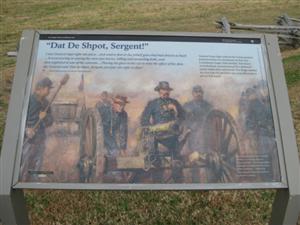
“General Franz Sigel ordered the Union gunners positioned here to concentrate on first one Confederate target, then another. Two hours of methodical, massed cannon shattered enemy battle lines and morale. Pea Ridge marked the first time this practice was used effectively in a Civil War battle.”
“Franz Sigel learned how to handle artillery as a young officer in Germany. Sigel – the second highest ranking Union officer in the Army of the Southwest – worked his way along the lines, moving from cannon to cannon.”
“That Beautiful Charge” Interpretive Sign text reads as follows:
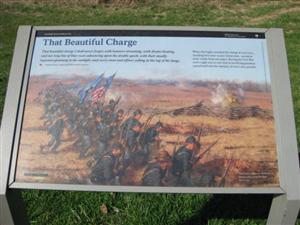
“When the bugles sounded the charge at 10:00 a.m., standing here were 10,000 Union men – an entire army visible from one place. During the Civil War such a sight was so rare that its terrifying grandeur seared itself into the memory of every man present.”
“The Union line stretched about a mile across the field before you.”
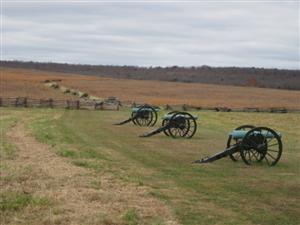
Union Brigadier General Samuel Curtis felt upbeat about the day's fighting. Although the Fourth Division on the Federal right had been forced to withdraw south from their initial position, they had fought well for over seven hours against substantial, if not overwhelming, odds. 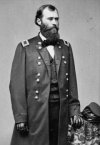 Colonel Eugene Carr had been wounded several times, but had stayed in command, actively directing his troops. In 1894, Carr was awarded the Congressional Medal of Honor for his actions that day in which he “directed the deployment of his command and held his ground, under a brisk fire of shot and shell in which he was several times wounded.” But his forces in Federal center had won an overwhelming victory and his troops on his left had not been engaged at all.
Colonel Eugene Carr had been wounded several times, but had stayed in command, actively directing his troops. In 1894, Carr was awarded the Congressional Medal of Honor for his actions that day in which he “directed the deployment of his command and held his ground, under a brisk fire of shot and shell in which he was several times wounded.” But his forces in Federal center had won an overwhelming victory and his troops on his left had not been engaged at all.
After the fighting stopped, Curtis immediately began organizing his forces in preparation for renewed fighting in the morning:
“The enemy ceased firing, and I hurried men after the caissons and more ammunition. Meantime I arranged the infantry in the edge of the timber, with fields in front, where they lay on their arms and held the positions for the night. I directed a detail from each company to bring water and provisions, and thus without a murmur these weary soldiers lay and many of them slept within a few yards of the foe, with their dead and wounded comrades scattered around them. Darkness, silence, and fatigue soon secured to the weary broken slumbers and gloomy repose. The day had closed in some reverses on the right, but the left had been unassailed, and the center had driven the foe from the field.”
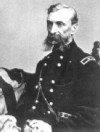
Brigadier General Alexander Asboth was uneasy about the Union army's chances on Saturday morning. He felt that they were going to be facing close to 40,000 enemy soldiers and that the Federals had suffered many casualties in the day's fighting. Asboth sent one of his staff to Curtis to request a council of war. Curtis replied that a meeting was unnecessary, saying “...in the morning I will attack at Elk Horn Tavern and will whip the rebels there, and when I whip them there, I whip them everywhere.”
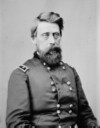 Curtis ordered Colonel Davis to move the rest of his Third Division forces into line on Carr's left. Davis would deploy his division astride the Wire Road. Colonel Julius White's Second Brigade would be west of the Wire Road and Colonel Thomas Pattison's First Brigade would be in the woods at the southern end of Ruddick's Field with what remained of Carr's Fourth Division on his right. Sigel finally reached Curtis around 2:00 A.M. and Curtis ordered him to deploy the First and Second Divisions to the west of the Wire Road. Osterhaus First Division would be situated to the left of Davis and Asboth's Second Division to the left of Osterhaus.
Curtis ordered Colonel Davis to move the rest of his Third Division forces into line on Carr's left. Davis would deploy his division astride the Wire Road. Colonel Julius White's Second Brigade would be west of the Wire Road and Colonel Thomas Pattison's First Brigade would be in the woods at the southern end of Ruddick's Field with what remained of Carr's Fourth Division on his right. Sigel finally reached Curtis around 2:00 A.M. and Curtis ordered him to deploy the First and Second Divisions to the west of the Wire Road. Osterhaus First Division would be situated to the left of Davis and Asboth's Second Division to the left of Osterhaus.
Having been used in piecemeal fashion during the fighting on March 7th, the Federal artillery was all being deployed for the next day's fighting. The 1st Iowa and 3rd Iowa (Dubuque) Batteries were at the southeastern edge of Ruddick's Field. But most of the Federal artillery would be deployed in the fields to the west of the Wire Road. Curtis would deploy 21 artillery pieces in the fields west of the Wire Road. He would also order three cavalry regiments to protect his left flank near Ford's Farm.
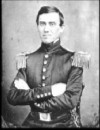 Confederate Colonel Henry Little wrote about the activity behind the Federal lines in his official report:
Confederate Colonel Henry Little wrote about the activity behind the Federal lines in his official report:
“During the night great commotion was audible in the camp of the enemy. Their artillery and baggage wagons seemed to be continually moving.”
Back: Skirt of Timber
Next: Welfley's Knoll

